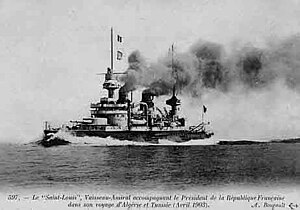 St Louis, April 1903
| |
| Class overview | |
|---|---|
| Name | Charlemagne |
| Builders | Brest and Lorient shipyards |
| Operators | |
| Preceded by | Bouvet |
| Succeeded by | Iéna |
| Built | 1894–1899 |
| In service | 1897–1931 |
| In commission | 1897–1915 |
| Completed | 3 |
| Lost | 1 |
| Scrapped | 2 |
| General characteristics | |
| Type | Pre-dreadnought battleship |
| Displacement | 11,275 t (11,097 long tons) (deep load) |
| Length | 117.7 m (386 ft 2 in) |
| Beam | 20.3 m (66 ft 7 in) |
| Draught | 8.4 m (27 ft 7 in) |
| Installed power |
|
| Propulsion | 3 shafts, 3 triple-expansion steam engines |
| Speed | 18 knots (33 km/h; 21 mph) |
| Range | 4,200 miles (3,650 nmi) at 10 knots (19 km/h; 12 mph) |
| Complement | 727 |
| Armament |
|
| Armour |
|
The Charlemagne class consisted of three pre-dreadnought battleships built for the French Navy in the 1890s. The ships spent most of their careers assigned to the Mediterranean Squadron (Escadre de la Méditerranée). They had oddly eventful peacetime careers as they were involved in four accidental collisions among them, one of which sank a French submarine with all hands. Saint Louis was usually a fleet flagship during her career and Charlemagne twice participated in the occupation of the port of Mytilene on the island of Lesbos—then owned by the Ottoman Empire—once as part of a French expedition and another as part of an international squadron.
During World War I, they were initially used to escort Allied troop convoys in the Mediterranean. All three ships were ordered to the Dardanelles in November 1914 to guard against a sortie into the Mediterranean by the German battlecruiser SMS Goeben. Charlemagne and Gaulois joined British ships in bombarding Turkish fortifications in early 1915 while Saint Louis was briefly assigned to bombard Turkish positions in Palestine and the Sinai Peninsula. Gaulois was badly damaged by a Turkish shell during one of these bombardments and had to beach herself to avoid sinking. After repairs she returned to the Dardanelles and rejoined her sisters, providing fire support during the Gallipoli Campaign until the Allies evacuated their troops. Saint Louis and Charlemagne were transferred to the squadron assigned to prevent any interference by the Greeks with Allied operations on the Salonica front in 1916 and Gaulois was en route to join them when she was sunk by a German submarine later that year.
The two surviving ships were placed in reserve during 1917. Charlemagne was decommissioned later in 1917 and sold for scrap in 1923. Saint Louis briefly became a training ship in 1919–1920 and was then converted to serve as an accommodation hulk in 1920. She was not sold until 1933, although she had been listed for disposal in 1931.